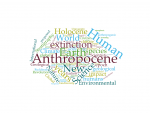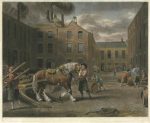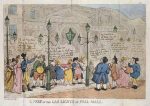This special collection for The 18th-Century Common is Guest Edited by Kent Linthicum (Brittain Postdoctoral Fellow at the Georgia Institute of Technology).
This collection of short public humanities essays illuminates and interrogates the marks of the Anthropocene upon long eighteenth-century cultures and/or responses by this period’s cultures to what is now called the “Anthropocene.” While debate concerning the start of the Anthropocene will continue into the foreseeable future, the stratigraphic distinction between 1750 and 1950 will likely be insignificant to geologists thousands of years from now. Presently though—roughly two-hundred years after the first coal-powered steam engines began to pump water out of English mines—examining the social systems that caused the Anthropocene is key to modern approaches to the same slow crisis. The long eighteenth century is a significant juncture in Anthropocene history, marking the apex of the Little Ice Age, the beginning of the Industrial Revolution, the height of the trans-Atlantic slave trade, the continued expansion of colonialism, the theorization of capitalism, and the era of Enlightenment, among other developments. Modernity has grown from and is affected by the climatological, energetic, material, capital, and theoretical stratum of eighteenth-century cultures. How did such cultures embrace, ignore, or reject the changes we now correlate with the Anthropocene? What are significant historical moments in the eighteenth century that help lay the groundwork for the Anthropocene? What political decisions helped establish pathways to the Anthropocene or tried to divert those trajectories? How did growing scientific fields consider the relationship between the human species and its environment? How was environmental insecurity (re)conceptualized in the face of increasing human impact upon the world? How did new technologies contribute to an Anthropocene trajectory? What caused these technologies to become normalized? How did aesthetic modes—music, visual arts, literature—respond to the deepening socio-environmental changes brought on by Anthropogenic forces? How can the effects of the Anthropocene be registered in the daily lives of eighteenth-century peoples? The essays in this in-progress special collection explore these and related lines of inquiry.
July 8, 2019
Like many human-made environmental disasters, Mobil Oil Company’s Colocotroni oil spill in 1973 is remembered today as a freak accident aggravated by human error; an exception rather than the rule of oceanic commerce. It would be more appropriate, however, to locate in this incident something emblematic about maritime trade in the Anthropocene.
March 12, 2019
Could Mary Shelley’s novel The Last Man (1826)—which imagines the end of humanity one hundred years in our own future and depicts natural disasters, like floods and earthquakes, alongside an unstoppable plague—be an early warning about the Anthropocene?
February 22, 2019
In the twenty-first century, humans have supplanted volcanoes as a major catalyst of climate change. The connections among industrialization, volcanoes, and climate change, which both signal and describe the Anthropocene, form a tradition in eighteenth-century British writing, pointing to 1750 as the dawn of the Anthropocene.
November 19, 2018
Who is the Anthropocene for? Who speaks for it? Who does it represent, and who does it erase? The question we must ask is this: In what ways is a certain structural violence, a colonial violence, smuggled in under the covers of this definition? To think about this dark side of the Anthropocene requires attention to the erasure inherent in this definition of the anthropos (by its Greek roots, a white, universal, European subject).
May 14, 2018
John Evelyn’s Fumifugium is an originary biopolitical text. Its arguments are grounded in the fact, attested by eighteenth-century Bills of Mortality, that air pollution was a public health disaster even as it was caused by economic activities meant to keep the population alive and growing.
April 18, 2018
Thinking about eighteenth-century British culture helps to frame why “Capitalocene” rather than “Anthropocene” may be the better term and why the story we tell about our environmental crisis matters.
April 16, 2018
America serves Locke throughout the Second Treatise as a distant place through which to imagine a distant past.
April 9, 2018
Felicia Hemans’s poem “The Illuminated City” (1826) is said to have been inspired by the celebrations of 1814 and the installation of gas lights in London. The text evokes a key moment in English national, imperial, and even–as we inhabitants of the Anthropocene might say–a planetary history.
January 23, 2018
Modern adaptations of Jane Austen’s works rarely emphasize climate change. The intrigues of Austen’s protagonists are capacious enough to accommodate murder mysteries, high school dramas, and even zombies. Yet climate fiction, or “cli-fi,” has yet to re-imagine Longbourn, Mansfield Park, or Donwell Abbey.








